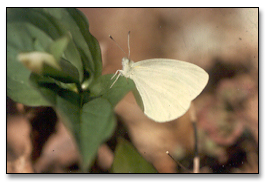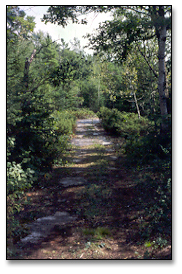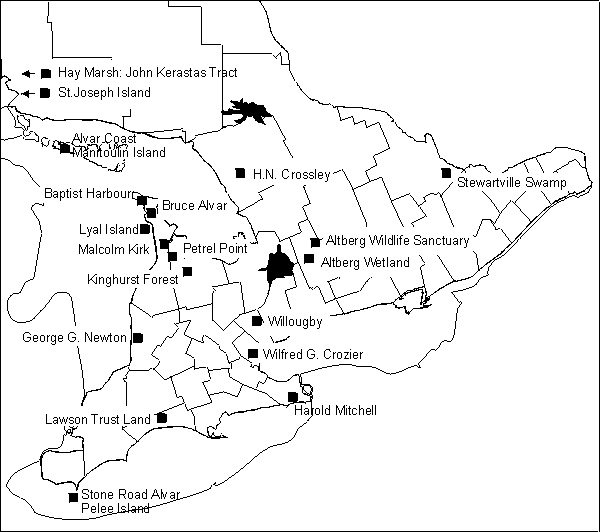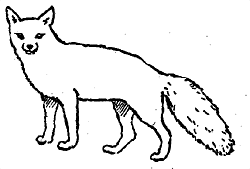Theme 5: Provincial Policies, Programs, and Plans
 |
|
hognose snake
|
Overview
Theme 5 introduces and summarizes provincial policies, programs and plans, using Ontario
as the primary example. This includes habitat protection, monitoring, and recovery
programs for species at risk, and an overview of some related provincial legislation.
What's happening to...
Ontario is home to some 3,000 species of vascular plants, 450 mosses and liverworts,
1,000 fungi, lichens and algae, and 600 vertebrates--including 302 breeding birds,
84 mammals, 24 reptiles (eight turtles, one lizard, 15 snake species),
24 amphibians (11 salamanders, 13 frogs and toads), and 150 fish species.
In addition, estimates indicate that there may be 130 species of
lepidoptera, and unknown numbers of other invertebrates.
Approximately four species have already been extirpated from the province and six species
are extinct. Over 24 additional species have not been reported in the last 20 years
and may be extirpated from Ontario. As of June 2003, there are about 175 species
listed as at risk in the province.
The causes for species decline are many and follow patterns similar to those discussed in previous themes:
-
Habitat loss, including draining of
wetlands, converting habitats into urban, agricultural, and industrial areas, ecologically unsustainable
logging, mining;
-
pollution, acid rain, pesticide, herbicide, and insecticide use;
-
climate change;
-
fire suppression;
-
excessive killing (e.g., poaching);
-
competition from introduced, invasive species.
Who does what?
-
Ornithologists study birds.
-
Entomologists study insects.
-
Experts who study frogs, toads, salamanders and turtles are called herpetologists.
-
Ichthyologists are experts in fish biology.
-
Those whose expertise is in plants are botanists.
-
What might mammalogists do?
|
What's happening for...
 |
|
West Virginia white butterfly.
Photo: FON |
For the most part, there must a cooperative relationship between the
federal government and all other levels of government when it comes to managing
some species and habitats.
As reviewed in the previous theme, most wildlife management is the responsibility of the province and its municipalities.
For example, the Ontario Ministry of Natural Resources (OMNR or MNR), formed in 1972, is responsible for the province's wildlife, among other things. MNR deals with provincial land use, and
promoting and regulating the various resource interests. These include forestry, mining, provincial parks, hunting, and eco-tourism, while also ensuring that the lands and waters under the
jurisdiction of the provincial government are used in the best interests of the
people of Ontario.
As explained in Theme 3 ("Designating species at risk"),
COSSARO assesses the provincial status of Ontario species at risk, and in this way
recommends to MNR which species should be designated at risk and/or protected under
the Endangered Species Act.
As of April 2003, 36 species are regulated in Ontario, under the Endangered Species Act
with seven having been added in 2003 (see list below).
An Ontario species either has an MNR designation or not, and it may or may
not be designated by COSEWIC. For example, the Acadian flycatcher, an Ontario bird species found in the Carolinian forest region (see Theme 6)
is designated by COSEWIC as endangered, but it is not designated by MNR/COSSARO, and is not regulated under the Ontario Endangered Species Act. A significant number of the flowering plants and fish designated by COSEWIC that occur in Ontario also
fall outside the protection of Ontario's ESA, though they may be under
review by COSSARO.
Endangered Species in Ontario Regulated Under the Endangered Species Act
* these four species are probably now extirpated.
Policies, programs, and plans ... oh my!
The provincial government administers numerous acts to regulate what can and cannot be done in the province.
The following list gives a few of the provincial acts related to wildlife and species at risk.
Educator's note:
The Ontario Ministry of Natural Resources provides fact sheets on many of these Acts.
Visit them online at www.mnr.gov.on.ca.
|
Provides for the conservation and protection of species of flora and fauna that
are threatened with extirpation or extinction in the province. This Act prohibits
wilfully killing, injuring, interfering with or taking of species protected by it, and
prohibits wilful destruction of or interference with habitats of regulated species.
It also states that no person shall wilfully attempt to do any of the above. People convicted of violating this Act may be fined up to $50,000 and/or sentenced to
up to two years in jail.
Regulates the possession, trade, and transport of numerous species, indirectly
protects others for which hunting permits do not exist, and increases penalties for the illegal commercialization of legally hunted wildlife species.
Because so many of Ontario's species are forest-dependent, this Act can play
a significant role in protecting species at risk. The Act requires that a forest
management plan is prepared for every forest management unit which, among
other aspects, must "have regard to plant life, animal life..."
and "...provide[s] for the sustainability of the Crown forest...".
(The Act does not apply to Crown forest in a provincial park).
This Act can play an important role in protecting habitat of threatened or
endangered wetland species at risk. The Planning Act requires Ontario
municipalities to identify natural heritage features and areas in their official
plans, and protect them through policies and zoning. Ontario's Wetlands
Policy is part of the Natural Heritage component within this Act.
Legislation itself cannot ensure that populations of species at risk will increase,
or that habitats will be recovered.
This is where programs and plans, like those briefly described next,
help carry out the recovery and protection of species at risk and their habitats.
Monitoring and recovery programs
Recovery programs for species at risk in Ontario are generally handled by MNR, which
provides staff and funds for
recovery programs, plans, and teams.
Recovery efforts for more than 60 species are underway including
eastern Massasauga rattlesnake,
the Blanchard's cricket frog,
the eastern spiny softshell turtle,
blue racer snake, several fish species and numerous plant species.
Monitoring of Ontario species at risk can often involve volunteers to help gather data.
For current information on specific monitoring programs, other details, and volunteer
opportunities,
refer to the Environment Canada Web site (www.on.ec.gc.ca).
Habitat Protection
 |
|
Karner blue butterfly
|
In addition to dealing with soil erosion and flooding, conservation authorities (CAs) now
protect important wetland habitats for many species at risk. For example, the
Niagara Peninsula Conservation Authority originally owned a portion of the wetland called
Wainfleet Bog. The most southerly bog of its size in Canada--where
peat mining occurred up until the late 1980s--Wainfleet Bog now provides habitat for
12 species at risk, including the
eastern Massasauga rattlesnake,
spotted turtle, and
Fowler's toad.
The Nature Conservancy of Canada today owns Wainfleet Bog, at just over 1,600 hectares, thanks to the early efforts of the Niagara Peninsula Conservation Authority.
Unfortunately, government cutbacks in the 1990s reduced the number of conservation programs. Some CAs have
considered selling various lands under their authority in order to have sufficient funds to manage remaining areas.
 |
|
Misery Bay alvar.
Photo: H. Gault |
The FON has an extensive Nature Reserves program and network that, in addition to
preserving unique and ecologically valuable areas, also serves to protect species at risk.
For example, their nature reserve on Pelee Island, and another on the Bruce Peninsula,
protect many species officially designated endangered, threatened, or vulnerable in
Ontario. The FON has nature reserves throughout the province and is the largest private
owner of nature reserves in Ontario. (See map below.)
In addition to the FON's Nature Reserves program, naturalists clubs, land trusts and
other groups also own
sanctuaries that protect species at risk. The Hamilton Naturalists Club, for example,
on the Niagara Peninsula, owns the Short Hills Sanctuary.
This 12.5 hectare, protected habitat is home to species such as the
American chestnut tree.
The Port Franks Karner Blue Sanctuary, owned by Lambton Wildlife Incorporated,
is another example of habitat which, hopefully, will provide reintroduction opportunities
for the extirpated Karner blue butterfly.
 |
|
Map of FON Nature Reserves and properties
|
The roles of people
Individuals can be involved in recovery efforts from counting birds or other species on their property, to restoring degraded habitats, or being stewards of small or large portions of their land.
In western Canada, for example, farmers and ranchers have been instrumental in the successful recovery of the endangered swift fox. Ontario's Land Stewardship program provides opportunities for landowners to help wildlife by providing financial incentives to enhance or maintain critical habitat, protect nesting sites, conduct surveys of species on their property, and provide special population data to the Natural Heritage Information Centre.
Non-government organizations
Non-government organizations provide opportunities for people to join groups that help species at risk and habitats in jeopardy. Two examples of provincial NGOs are:
The FON is dedicated to protecting and conserving Ontario's natural heritage,
and and represents 25,000 members and supporters and a network of over
120 local naturalists' clubs.
Through its programs of education, scientific research, advocacy, and nature protection,
the FON promotes the preservation of wetland habitats, the creation and management of provincial and national parks in Ontario, the protection of Ontario's imperilled wildlife, and responsible forest management.
Founded in 1968 as the Algonquin Wildlands League, the Wildlands League is today
a chapter of the Canadian Parks and Wilderness Society.
The Wildlands League has led the way on provincial issues such as establishing a
scientifically sound system of protected areas and parks, ensuring the sustainable use of resources, and drawing attention to the links between healthy environments and healthy communities.
What you can do!
 |
|
swift fox
|
Write
to your provincial representative to
let them know your opinion on the
protection and recovery of Ontario's species at risk, and the protection of natural habitats. Send a copy of the
letter(s) to a naturalists' club or group, or other NGO working on the issue
"for their information."
It is always appreciated.
Join
the FON and your local naturalist club or group to learn about species at risk.
And to support broad-based efforts to protect Ontario's species at risk.
Help
monitor species at risk in your area. Contact the FON or
those listed on
Environment Canada's Wildlife Watcher's Web site ( www.on.ec.gc.ca).
|
|
|
|